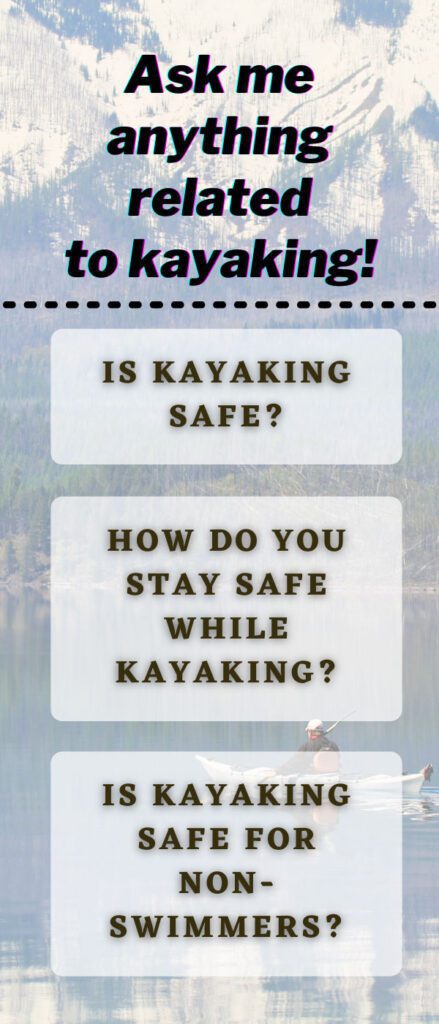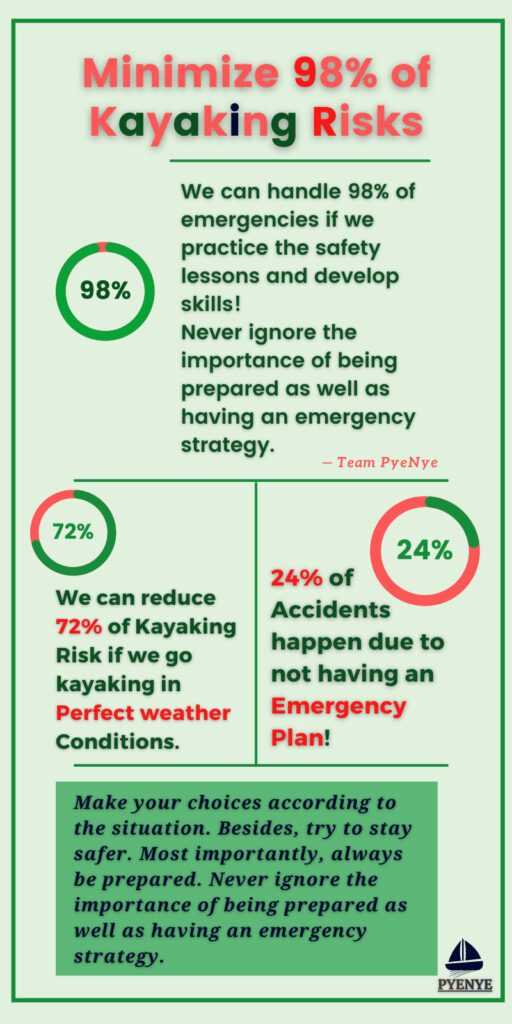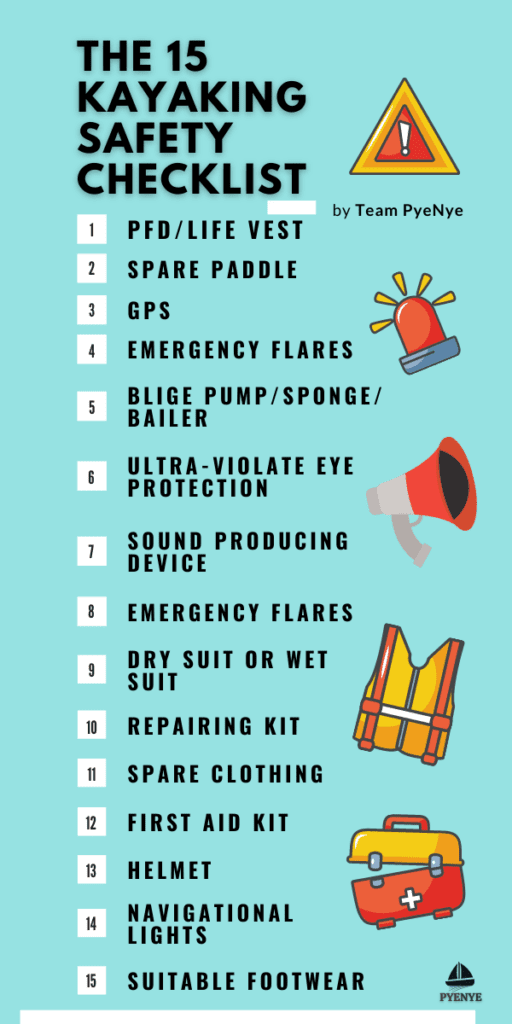When you are planning for a kayaking trip, be sure that you have gone through the safety lessons! Practicing the lessons properly is the most significant thing for ensuring kayaking safety. However, you shouldn’t be overlooked! Besides, you can get safe kayak trip planning ideas from here.
Above all, kayaking is one of the supreme adventurous water activities of today’s time. First of all, you need to measure out the risk factors, bring the essentials, wear the perfect clothing for a hassle-free kayaking journey.
Here, we are presenting the 19 best kayaking safety tips for having safe kayaking experiences.
Actually, dry and slightly warm weather is perfect for kayaking. We’ve also added guidelines for kayaking in the freezing weather.
PyeNye Blog

First of all, have a look at some common queries;
Kayaking is safe if you know the safety guidelines. As it’s an adventurous activity it’s never 100% risk-free. However, by maintaining the kayaking safety guidelines you can make it safer. However, buy a perfect kayak according to your plan.
We first need to carry the appropriate safety equipment for staying safe while kayaking. In the kayaking safety checklist, we must wear PFD, carry extra paddles, dry foods, knives, GPS devices, mobile, dry bags and etc.
On the other hand, develop skills and techniques for emergency situations. At times these skills and techniques are lifesaving!
Actually, I would not recommend water adventures for the non-swimmers. For the non-swimmers, it can be quite challenging to fish from a kayak, kayak around the ocean, and solo kayaking. Without swimming, you cannot get complete enjoyment from kayaking as well as from other water activities.
But there are always some other ways. Above all, make sure you are developing your skills, and keep practicing the safety lessons.

Let’s measure the risk factors of kayaking first.
Jump To A Section
Measure The Risk Factors For Kayaking Safety
Measuring the risk factors is one of the vital portions of safe kayaking. It is necessarily important to figure out the dangers before you go kayaking. Remember, kayaking is not the same in different waters. For example, bay kayaking is different than whitewater kayaking and river kayaking.
On the other hand, when you are planning for fishing from a kayak then you need to study the water well for various things. You should study the water types, the waves, the different species of fish and reptiles, and a lot more things.
And before choosing a kayak, go through the secrets. For example, do you know how safe is inflatable kayaks? If not, first learn, then grab! Because it’s all about safety.
When it comes to the risk factors of kayaking, some of us have a lot of misconceptions about the risks of kayaking. And these misconceptions hold you back from having the best water adventure!!
Team PyeNye
As kayaking is an adventurous activity is not 100% risk-free. But the interesting all of the risk factors can be properly measured. Thereby, we can undertake all the situations. Sun Expose, Hypothermia, Cold Shocks are the vital risks of kayaking. And these all have preventions.
All we need to do is to prepare ourselves well for the journey. In the article, we are covering vital safety equipment so that you can make yourself prepared for such risks during your kayaking.
First of all, take some time for planning your kayaking well. Make clear decisions on your purpose and type of kayaking. Whether you are going for lake kayaking, kayak fishing, or kayak camping there are always some specific safety guidelines for different purposes of kayaking.
The 19 Life Saving Kayaking Safety Tips
We can understand better, that adventurous activities can never be completely free from dangers. On the other hand, life is much more entertaining by the adventures. Thereby, we need to develop our skills and techniques for ensuring the safeties as well as for the better enjoyment.
Well, here we have prepared a compilation of life-saving kayaking safety tips. By the end of the article, you would learn all the best safety tips for kayaking. From your first day at kayaking, these safety guidelines would help you ensuring safety in any emergencies. Besides, kayaking is a good exercise.
For better understanding, we have categorized the entire kayaking safety in two (2) sections; Beginners’ Kayaking Safety, and Advanced Kayaking Safety.
Let’s make kayaking safer by learning from the following kayaking safety tips;
Beginners’ Kayaking Safety Guidelines
Kayaking may seem a hard and unsafe activity for beginners. But when you come closer to kayaking, you would realize that kayaking is neither that hard nor that risky.
Besides, you can have a look at our blog posts on “Is Kayaking Hard?”. These two articles would really help a beginner lessen the kayaking difficulties and would make your kayaking easier than before.
Be Aware Of Emergencies While Kayaking
Kayaking is an adventurous activity. Thereby, it can never be 100% risk-free! Yes, this is true. But there are lessons which can ensure the safeties. Despite just how well planned a journey, exactly how proficient the group or exactly how familiar a section of the river. Here are the guidelines for Green River kayaking.
Make your choices according to the situation. Besides, try to stay safer. Most importantly, always be prepared. Never ignore the importance of being prepared as well as having an emergency strategy. The following safety tips will help you deal with the emergency situation;
The 11 Safety Tips For Kayaking Emergencies
- Always get in touch with the weather conditions.
- Plan your trip according to your kayaking skills and ability.
- Learn backstrokes, rolling in your practice session.
- Reentering a kayak in the water is a mandatory skill. Learn it as soon as possible.
- Carry an additional paddle concerning emergencies.
- Concentrate on your clothing. Dress according to the weather condition, and avoid cotton.
- Keep some first aid kits.
- Make someone aware of your journey. Here’s how diy first aid kits.
- Paddle calmly when you are in the alligator’s zone. Here’s more on kayaking with the alligators.
- Try kayaking in a group, it’s much safer than solo!
- Develop your own emergency plan.

Decide Where To Go For Kayaking
This is a key fact. Especially, for having a safe kayaking experience. There are different types of kayaking for different purposes. Compared to other water activities sea kayaking, kayak fishing, whitewater kayaking, kayak camping are more entertaining.
This is why we need to decide our purpose and places for kayaking. However, you can try kayaking in the Hudson River.
Train Yourself To Re-Enter The Kayak
Re-entering the kayak is one of the most vital facts in kayaking. It’s essential in your kayak learning checklist. Because of the shape, kayaks can flip over. What if your kayak flips over during the journey? That’s why you need to get prepared for such situations.
We recommend, practice re-entering the kayak from the early period of your kayak learning. It is highly recommended to ensure that you can re-enter the kayak whenever it flips over.
Re-entering the kayak may seem like a disaster. Especially for the beginners. Here we have 3 simple steps. This will make this easier and safer. The first step after your kayak flips is to turn it over. Moreover, it’s quite puzzling for beginners. Then, the next step comes with infilling your kayak.
Here you need to empty your kayak out of water. Then, it comes to the last step of re-entering. Which is all about climbing back in your kayak. A proper combination of these three steps is essential for ensuring kayaking safety.
Avoid Solo Kayaking At The Early Periods
Sometimes solo kayaking brings to mind playing in the divine nature. Moreover, the aesthetic nature makes the new kayakers more curious. Even it becomes hard to prevent ourselves from going solo from the early periods of kayaking.
At the beginning stage, we should involve in group kayaking. As we can get supports from our groupmates. After a few sessions of group kayaking, we’d be able to develop our kayaking skills. Therefore, our kayaking experiences would become much easier. Then we can go for solo kayaking trips without any hesitation.
We have featured an article on Solo Kayaking Trips, And this article presents everything for making your solo kayaking easier.
What To Wear For Kayaking
Kayaking has become a diversified adventure in today’s world. That’s why we need to know the different kayaking activities for dressing up appropriately for kayaking. There are a lot of purposes for kayaking. We’re very much fond of using kayaks for fishing, camping, touring, and other recreational activities. And for these different types of kayaking, there are particularly different water types.
For example, whitewater kayaking is not the same as bay kayaking. On the other hand, Kayak camping and kayak fishing are not the same.
Actually, choosing the appropriate clothes for kayaking is not that easy. We actually become messed up with our dresses. Yes, this sounds silly, but sometimes we forget to consider what to wear for comfortable kayaking?!
Now in a brief,
There are mainly three factors that we need to consider while we’re planning for the trip. The first thing is about our purpose for kayaking, the second one is about weather conditions, and the third one is about the water type that you will be kayaking on.
5 Simple Tips for choosing the appropriate kayaking dresses
- Try avoiding cotton dresses. Because, it absorbs water quickly, and remains wet for a long time.
- Use suitable footwear for better kayaking. It can be sandals, water shoes, or even boots.
- Wear your dresses according to the weather condition. For example, wear shorts when you are going for a summer kayaking.
- Keep additional wetsuit or drysuit according to the weather condition.
- Above all, keep your head well protected. Using a helmet, cap or hat can be very helpful for protecting your head from the excessive heat of the sun. Besides, it will make you safer from other dangers.
What To Carry For Kayaking
It’s a pretty common query! Most of the new kayakers become confused with this. Selecting things for carrying isn’t a job. As kayaking has different purposes and activities, we should first decide the one that we’re going to perform. It’d make figuring out the essentials much easier.
For example, if we’re going for kayak fishing, we mostly need fishing-oriented equipment along with the kayaking essentials. On the other hand, while going for kayak camping tours, we should focus on safety items.
Other than that, depending on the type of kayaking trip you plan, you’ll need certain supplies. Here are a few things without which you should never kayak:
Perfect Paddle: A paddle is just as important as a kayak. Do you know whether kayak paddles float or not? You must consider measuring your torso and the breadth of the kayak you are paddling when selecting a paddle.
Torso heights of more than 28 cm are available, although paddles of less than 200 centimeters and torso heights of less than 28 centimeters are typically used in paddle lengths. Besides, you can learn about kayak’s weight from here.
Floating Devices: A personal float device is an important component of the equipment you should always carry in any sport. A lifejacket should fit snugly and fit comfortably without feeling excessively tight or loose. Here’s the detailed information.
Bilge pump: A bilge pump or bailer is necessary in case you need to quickly bail water out of your kayak. A Blige pump is one of the most essential tools for getting the waters out of the kayak.
Here we have prepared a basic carrying list for kayaking. Let’s have a look;
- Dry bags are mandatory, don’t forget to carry at least one.
- Keep enough food and drinks according to your tour plan.
- Prepare your carrying list according to the weather condition.
- Carry some first aid kits as well as some safety tools.
Advanced Kayaking Safety Tips
After we’ve gone through a few sessions of kayaking, we need to develop our safety skills for having hassle-free kayaking experiences. In the beginning stage, we have focused on the essentials and the basics. By the way, we have complete guidelines on kayaking workouts here.
Now it’s time to learn; how we can maintain good postures while kayaking, deal with kayaking emergencies, ensure comfortable adjustments, and preparing our kayaking safety checklist, and lots more.
Maintaining Good Postures While Kayaking
Posture is a vital thing for ensuring easy kayaking. When you are thinking about proper kayaking, then maintaining a good posture is a key thing. It is actually about the placement in which you are being in your kayak. Your pose will certainly have an enormous result on your kayaking.
Actually, after a few practice sessions, we can easily develop our comfortable posture. The thing is, most of us have no idea about kayaking postures. However, it’s necessary to know for having safe and comfortable kayaking
It doesn’t matter where you are going for kayaking, proper kayaking postures will assist you in every situation.
Here are some initial tips on maintaining a good posture;
- Always try to keep your feet straight.
- Learn to sit in or sit on a kayak properly.
- Ensure your back support.
- Focus on your adjustments.
- Paddle like swinging your hands as we do for swimming.
- Make some space so that you can adjust your position.
Here’s more about kayaking postures.
Ensuring Comfortable Adjustments
If you wish to make your kayaking experience memorable, you have to make your journey comfortable. Without ensuring comfort, you cannot enjoy the flavors of kayaking in the best way. Above all, it’s a tough job!
Adjusting a kayak to fit not just makes the watercraft extra comfy but additionally makes it simpler to manage. With the proper adjustment, edging, which aids you maneuver, really feels simpler. If you love dogs kayaking then get the adjustment guidelines for kayaking with a dog.
Moreover, rolling, backstrokes are much easier, as well as torso rotation, which pushes a kayak ahead being easier. So in order to enjoy the best flavor of kayaking, focus on flexibility by ensuring comfortable adjustments.
Value The Safety Equipment
Safety equipment is one of the vitals. This can be the key thing for having hassle-free kayaking trips. We always recommend valuing the appropriate safety equipment from the practice sessions. In fact, if you’re in any emergencies, the only thing that can help you is the safety equipment.
Let me explain this in a few words; what if the weather turned catastrophically? Do you know how to remain safe under thunderstorms? What to do if lightning strikes?
For such situations, we should maintain safety guidelines. By using the right safety equipment, we can reduce the danger, as well as can make our kayaking easier than ever. Here we are presenting, the mandatory equipment for ensuring kayaking safety;
Kayak Safety Requirement: The 15 Safety Checklist
When it comes to the safety equipment for kayaking, you should focus on your trip plan. Kayaking has a lot of different activities, like; whitewater kayaking, flatwater kayaking, bay are kayaking, freshwater kayaking, kayak fishing, kayak camping, river kayaking, and many more.
All these different kayaking needs some particular accessories. However, all these different kayaking have their own flavor of adventure!
Here in the following list, we’re presenting the 15 essential checklists for ensuring kayaking safety;
- Spare Or Additional Paddle
- Personal Floating Device (PFD)/ Life Vest
- Sound Producing Device Like Whistle
- Blige Pump/Sponge/ Bailer
- Emergency flares
- Navigational Lights For Kayaking At The Night
- Dry Bags
- Repairing Kit
- Global Positioning System (GPS)
- Ultra-Violate Eye Protection (Sunglasses)
- Enough Drinking Water And Food
- Appropriate Clothing
- First Aid Equipment
- Helmet For Particular Kayaking
- Suitable Footwear
- Dry suit or wet suit
- Sleeping Bags

Kayaking Safety Rules And Regulations
After a few weeks of kayaking, we need to develop our skills. After going through the basics, we need to get prepared, for all the possible emergencies. Here we’ll be discussing the four vitals. The first one is about life-saving skills. Then we’ll discuss dealing with waves. After that, we’ll share safeties for kayak fishing.
Remember, weather plays a vital role in kayaking. Get in touch with the weather forecast always. Prepare your checklist according to the weather condition. Besides, prepare a backup plan for your trip.
We have particularly cove Florida kayaking regulations here.
When should you not go kayaking?
If the weather condition seems clumsy you should not go kayaking. Weather plays a vital role in kayaking. It is necessary to get the weather forecast before you are going on the journey.
However, wear clothing according to the weather, keep dry bags, repair the kit, use signal-providing devices and practice safety lessons for making yourself prepared for any kind of emergency.
Fishing and Kayaking Safety Tips for Different Weather
Here are some guidelines for kayak fishing safeties. This will also help you to kayak in different weather conditions. However, you can also read key west kayak fishing secrets. Let’s have a look;
- Learn to understand the weather. It is a key fact. It’s a matter of experience.
- If you are kayaking in winter, fog can be a vital factor.
- 50 to 60 degree air temperature is good for kayaking. Check it before you’re going.
- Above 70 degrees of water temperature is perfect for kayaking. Besides, this is perfect for most of the water adventures.
- Always be aware of lightning and thunderstorms.
- If it begins to thunderstorm, paddle quicker to the shore. They have huge power. Reach the edge as soon as you can.
- Remember, when the lightning strikes not far away, it is much less probably that the current will circulation by means of your body system.
- Learn to deal with the waves. It’s usually needs experience. However, it’s an important fact in kayaking.
- Before going for kayak fishing, study the destination well.
- And make sure you remain visible to others.
- Use the appropriate fishing gear. For example, fish finder can be effective for passionate kayak fishers.
- Choose your cloths according to the weather and season.
- And practice the kayaking safety lessons in a schedule.
To sum up, these are the major factors that ensure safety while kayaking. We recommend you to practice the safety lessons in a schedule. However, it’s all about the experience. Take time and keep practicing our kayaking safety tips.


